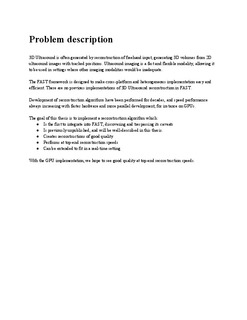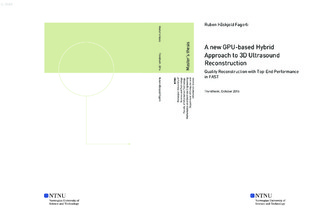| dc.description.abstract | Ultrasound imaging is a versatile, portable, and low cost medical imaging modality. It produces real-time data from a local area in the scanned person, or object, useful in use cases such as intra-operative imaging. Freehand 3D ultrasound reconstruction is technique used to convert sets of 2D ultrasound images into a 3D volume. It is prefered over direct 3D acquisition due to increased resolution and flexibility, and lower cost. However, freehand 3D ultrasound reconstruction requires tracking, which will contain inaccuracies.
Reconstruction algorithms are supposed to approximate the volume, given the overlap and gaps between input data, while taking position uncertainties into account. There are many existing solutions, from basic one-to-one solutions like Pixel Nearest Neighbor (PNN) and Voxel Nearest Neighbour (VNN), to compounding distance weighted solutions like Varying Gaussian Distance Weighting (VGDW). With the increasing power of Graphical Processing Unit (GPU) calculations, reconstruction can run faster, allowing more powerful methods to reach demands for new situations. In this thesis we propose a previously unpublished hybrid approach based on pixel-based methods. Voxel focus in accumulation, allows for a highly parallel, and computationally efficient method that can run at high performance. Variations in input distance is easily handled by a flexible distance weighting function.
Multiple configurations were tested, to improve the visual quality or performance properties of the algorithm. Visual evaluation by a group of ultrasound technologists proved that the hybrid approach can score at least as good as the VGDW, as the evaluators consensually scored two hybrid configurations slightly ahead of VGDW. Running on a Nvidia GTX 970 GPU high-end runtime performance was achieved, with sub-second reconstruction time on volumes with 32 million voxels, and very good scaling with bigger volumes. An alpha blending compounding method has been implemented, accumulating frames at a rate of 2000 frames per second, with no need for normalization. Hybrid accumulation performance is on line with PNN accumulation, yet without any need for a hole-filling step it severely outperforms PNN on overall performance. The hybrid algorithm scales particularly well with volume size, and is able to adapt well to varying distance between input frames. Additional improvements have been looked into for further work, as well as exploring the real-time solutions for this algorithm, or others. | |

